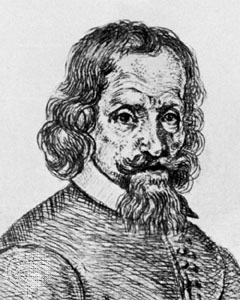Johann Rudolf Glauber facts for kids
Quick facts for kids
Johann Rudolf Glauber
|
|
|---|---|
 |
|
| Born | 10 March 1604 Karlstadt am Main, Germany
|
| Died | 16 March 1670 (aged 66) Amsterdam, Netherlands
|
| Nationality | German-Dutch |
| Known for | "Glauber's salt" |
Johann Rudolf Glauber (born March 10, 1604 – died March 16, 1670) was a German-Dutch alchemist and chemist. An alchemist was someone who tried to turn ordinary metals into gold. A chemist studies what things are made of and how they react. Some historians think he was one of the first chemical engineers. This means he used chemistry to solve practical problems. He discovered sodium sulfate in 1625. This chemical compound was later named "Glauber's salt" after him.
Contents
About Glauber's Life
Johann Rudolf Glauber was born in 1604 in Karlstadt am Main, Germany. His father was a barber. He came from a large family and did not finish school. However, he learned a lot by visiting laboratories. He also studied pharmacy, which is about preparing medicines. Glauber often said he was happy he learned through experience. He felt this was better than strict high school lessons.
His Travels and Work
Glauber moved around a lot during his life. He lived in many cities, including Vienna, Salzburg, Paris, and Frankfurt. He also lived in Amsterdam for several periods.
He first worked making mirrors. Later, he became an apothecary (a type of pharmacist) for a court in Giessen. He even became the Chief Apothecary there. He left this job because of the Thirty Years War. This was a long and difficult war in Europe.
In Amsterdam, Glauber started his own business. He made and sold pharmaceuticals, which are medicines. This included chemicals like Glauber's salt. His business was very successful for a while. However, he faced financial problems and went bankrupt in 1649. This is why he moved from Amsterdam to Wertheim.
Family and Later Years
Glauber married twice. With his second wife, Helena Cornelius, he had eight children. His son, Johannes Glauber, was an artist. He likely helped his father with drawings for his books.
In 1660, Glauber became very sick. Some people believe this was due to working with heavy metals. These are certain metals that can be poisonous. In 1666, he had a bad fall from a wagon. This left him unable to move easily. He had to stay in bed for the rest of his life. Because of his illness, he sold his books and equipment. This helped him provide for his family. He passed away on March 16, 1670, in Amsterdam.
Glauber's Important Discoveries and Inventions
Glauber was a very practical scientist. He studied the chemistry of making wine. He also found ways to improve this process. He even sold licenses for his improvements. As an apothecary, he made medicines. He was known for giving free medical help to people who were poor.
He made important contributions to inorganic chemistry. This is the study of chemicals that don't mainly contain carbon. He was able to earn a living from making chemicals. This makes him an early industrial chemist. He also improved chemical tools and methods. He made better furnaces (ovens for heating things) and distillation devices. Distillation is a way to separate liquids by heating and cooling them. These improvements show why he is called an early chemical engineer.
Key Chemical Discoveries
- Hydrochloric Acid: In 1625, Glauber was the first to make strong hydrochloric acid. He did this by mixing sulfuric acid with common table salt.
- Nitric Acid: In 1648, he found a better way to make nitric acid. He heated potassium nitrate with strong sulfuric acid.
- Glauber's Salt: He produced sodium sulfate, which he called sal mirabilis. This means "wonderful salt." It made him famous. This salt was a good and safe laxative. A laxative helps empty the digestive system. At that time, emptying the digestive system was a common treatment for many illnesses.
- Chemical Garden: In 1646, Glauber was the first to describe the "chemical garden." You can make one by putting ferrous chloride crystals into a solution of potassium silicate. This creates beautiful, plant-like structures.
Glauber was also the first to create and separate several other important chemicals. These include antimony trichloride, arsenic trichloride, tin tetrachloride, and zinc chloride.
His Writings
Glauber wrote about 40 books. One important book was Dess Teutschlands Wohlfahrt. This means Germany's Prosperity. In this book, he suggested that chemical industries could help Germany recover. This was after the difficult Thirty Years War. He believed chemistry could make his country rich again.
Images for kids
See also
 In Spanish: Johann Rudolph Glauber para niños
In Spanish: Johann Rudolph Glauber para niños


